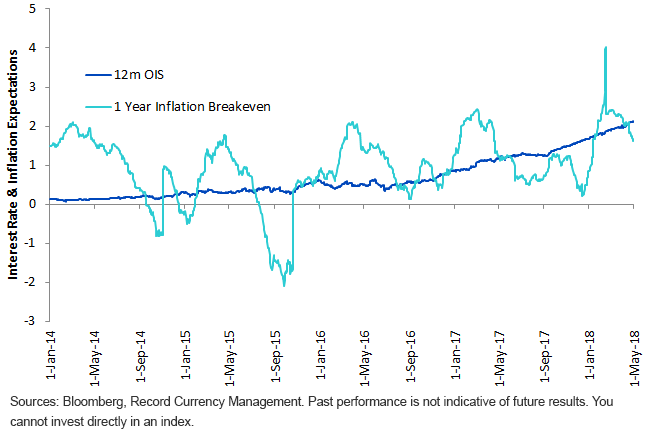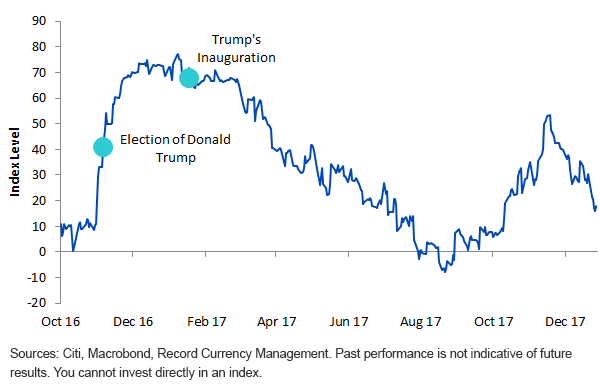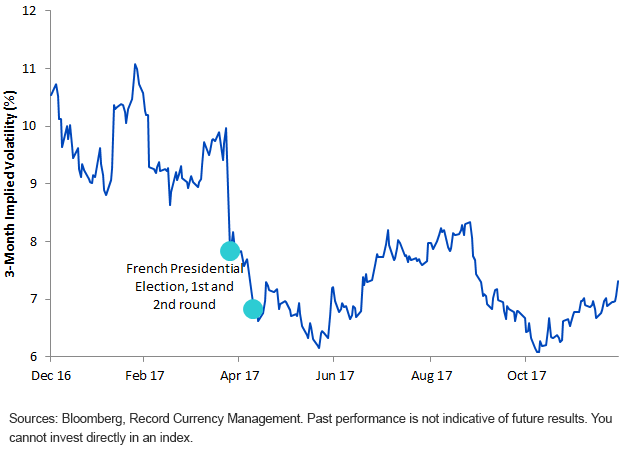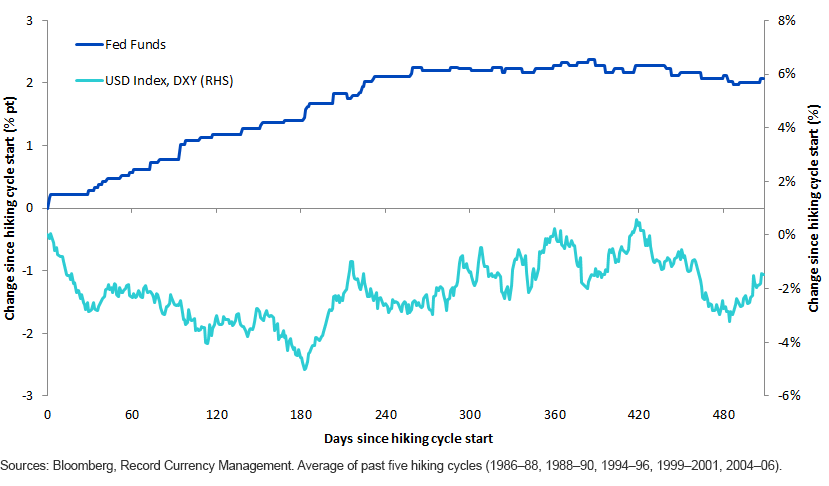U.S. Dollar Trifecta: Inflation, Elections, Policy


As we seek to understand movements of the U.S. dollar, we’ve noticed that there are three big-picture factors that come up time and again:
1. Inflation
2. Elections
3. Policy
Let’s evaluate each of these in turn.1
Rising Inflation Can Push U.S. Dollar Toward Weakness
Interest Rate and Inflation Expectations (March 31, 2014, to May 2, 2018)

- The 12-month overnight indexed swap (OIS) is indicative of what investors would receive if they were to roll the overnight interest rate over the course of a 12-month period, whereas the 1-year inflation breakeven takes the yield on the nominal 12-month t-bill minus the yield on the inflation-protected 12-month t-bill. Both have been on the rise as we’ve moved through 2017 and into 2018.
- Monitoring the picture of U.S. inflation using market-oriented gauges like this is of great value because it can help us look even beyond the U.S. dollar toward a toolkit of investments that might respond in a rising inflation environment. Stocks with growing dividends are of interest, as are other real assets, such as commodities, which can see their prices rise as somewhat of an inflation hedge.
U.S. Dollar Positioning Has Indicated Disappointment with President Trump
Citi FX Positioning Alert Indicator (PAIN) Index: USD Positioning (December 29, 2015, to December 29, 2017)

- The election and inauguration of Donald Trump saw great enthusiasm among dollar bulls who positioned themselves with lots of long-U.S. dollar exposure. The basis of this view was that the new administration would have the potential to extend the natural growth cycle, doing things like tax cuts and infrastructure spending late in the economic cycle.
- With the benefit of hindsight, we now know that even with Republican control in both the legislative and executive branches of the U.S. government, it was far from easy to implement a tax bill. An infrastructure spending policy remains to be seen as of this writing. This manifested itself in many dollar bulls becoming bearish, dramatically reducing their long-U.S. dollar positions. At times people have characterized the dollar weakness of 2017 as flow-related—this is a good gauge to provide evidence to that view.
Macron Election Opened the Door to Euro Strength
EURUSD 3-Month Implied Volatility (June 30, 2016, to December 29, 2017)

- One of the most influential (and in 2017 most surprising) currency pairs was the euro versus the U.S. dollar. The biggest story in the first part of 2017—especially after the Trump election victory—was of the so-called “populist uprising.” For markets, the most significant embodiment of that was Marine Le Pen. Her loss to Emmanuel Macron allowed investors to become a lot more comfortable with holding long-euro positions, as it was feared that a Le Pen victory would be a major turning of the tide toward euro skepticism.
- The euro-U.S. dollar 3-month implied volatility behavior does indicate a substantial lowering of implied risk in this exchange rate, the catalyst for which was the French election. During elections through the rest of 2017, the market never quite placed the same level of risk in the concept of euro skepticism, and one could think of this as removing an impediment to euro strength, as opposed to anything specifically related to dollar weakness.
Do Investors Have the Concept of Central Bank Policy Divergence Incorrect?
USD Index during Hiking cycles

- Capital flows toward higher relative interest rates and pushes up the value of higher-interest-rate currencies compared to lower-interest-rate currencies, right? In theory, yes, but in practice, like many aspects of thinking about currency movements, it is not that simple. Here we look at the average of the past five interest rate hiking cycles at the U.S. Federal Reserve (Fed). In general, these policy shifts have been more likely, at least historically speaking, to be accompanied by a weaker dollar than a stronger one.
- An explanation of the phenomenon, especially valid in today’s markets, is that the Fed is very apt to communicate a lot about its intended path of policy, not wanting to spook markets. As a result, when then Fed Chairman Benjamin Bernanke started talking about tapering quantitative easing purchases in May 2013, global markets reacted in a way that we now call the taper tantrum. Broad-based dollar appreciation followed. When we began 2017 or 2018, in contrast, market participants broadly have a baseline of SEVERAL EXPECTED policy hikes, and if anything the surprise would occur only in the other direction.
Bottom line: When thinking about central banks, investors should start from a standpoint of what might surprise markets with new information, rather than a widely anticipated environment of policy divergence.
Considerations for 2018 & Beyond
It will be important to continue monitoring these different factors, thinking about the potential for surprises. Will weaker economic data out of the eurozone inspire further easy monetary policy from the European Central Bank? Are there political risks in Europe, perhaps from Italian elections, that cause questions about the euro area? Will U.S. inflation surprise to the upside in significant fashion? The answers to these types of questions, in our view, will have the potential to shift the tides in currency markets much more than what investors largely know and expect today.
1We’d like to thank Record Currency Management, a global thought leader on currencies, for analytical support in this blog series.

Christopher Gannatti began at WisdomTree as a Research Analyst in December 2010, working directly with Jeremy Schwartz, CFA®, Director of Research. In January of 2014, he was promoted to Associate Director of Research where he was responsible to lead different groups of analysts and strategists within the broader Research team at WisdomTree. In February of 2018, Christopher was promoted to Head of Research, Europe, where he was based out of WisdomTree’s London office and was responsible for the full WisdomTree research effort within the European market, as well as supporting the UCITs platform globally. In November 2021, Christopher was promoted to Global Head of Research, now responsible for numerous communications on investment strategy globally, particularly in the thematic equity space. Christopher came to WisdomTree from Lord Abbett, where he worked for four and a half years as a Regional Consultant. He received his MBA in Quantitative Finance, Accounting, and Economics from NYU’s Stern School of Business in 2010, and he received his bachelor’s degree from Colgate University in Economics in 2006. Christopher is a holder of the Chartered Financial Analyst Designation.

